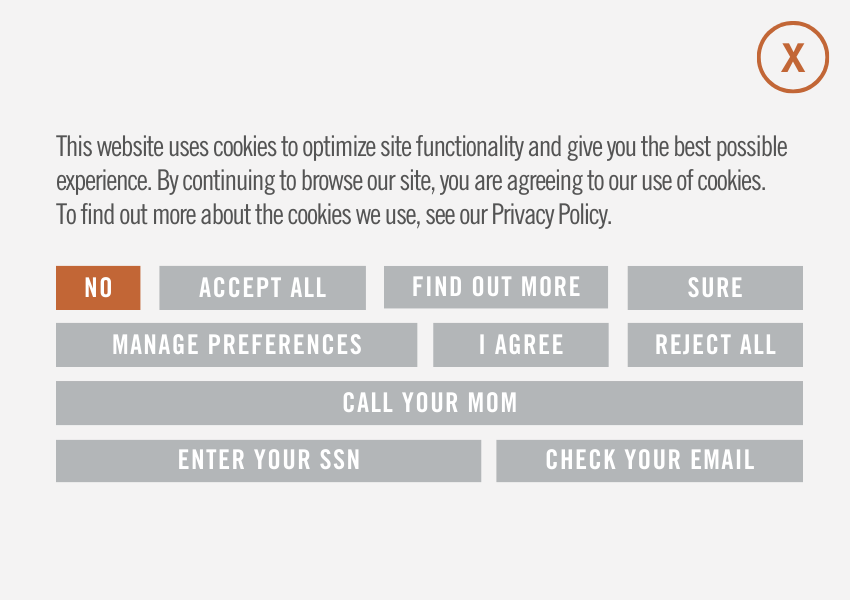5 Signs It’s Time for a Website Redesign
It can be difficult deciding how and when to undergo a website redesign. Redesigning a site requires a great deal of commitment on your part; and trust in those you have hired to handle the virtual face of your business. But having a website that frustrates your visitors or drives away traffic for any reason can be costly to your business.
All websites should be designed with several principles in mind such as easy-to-follow navigation, easy-to-use layout, pleasing aesthetics, and content management, just to name a few. Websites can be used for a variety of purposes from conducting eCommerce, to simply giving your business a professional face. No matter how you plan to use your site, an interactive and user-friendly design is crucial to your brand in this day and age. If you aren’t sure whether or not it’s time for a website redesign, check for these signs the next time you go through your site.
1. Your Website is Visibly Unappealing or Outdated
As the saying goes, you only get one chance to make a first impression, and these days your website is your first impression. Nothing will make someone click the back button faster than arriving to your site only to be met with something that looks like the Space Jam homepage (Yes, this is the original site—no you can’t play the games, you’d need Shockwave).
Speaking of outdated software, with the current trends in mobile development, Flash will no longer be supported in the future and HTML 5 will soon take its place. If your site relies on Flash, this is a good time to consider a redesign, before your search engine rankings are affected by optimization.
Another common design mistake is to spew out every bit of information you have on your subject at once on the homepage. As interesting and informational as that info may be, the fact is people didn’t come to your website to read, they came to gather info on you. Specifically, potential customers want to know, What do you do and how do you do it? Why should I select you? How should I interact with you? While you don’t want to skimp on essential details, in this situation, less is more.
2. Your Website Isn’t Mobile Responsive
The days of needing a computer to access the Internet are long gone, and the mobile device market has exploded. Smartphones and tablets have revolutionized the way people are accessing the web and getting their information. We now know that more than 20% of Google searches are being performed on a mobile device, and that 1 out of 4 Internet users in the U.S. only access it on a mobile device.
Having a responsive website design means that your website has been built so that the structure, content, and images of the website all appear the same on any device. This means that customers will be able to easily use your website no matter the device they are using. This is vital because recent data has shown that 67% of smartphone shoppers will switch to a competitor’s website if their eCommerce check-out process is faster. Customers want everything to be as easy as possible, and a responsive website is necessary for a user-friendly experience.
In addition to these problems, you will also find that if your website is not mobile friendly, Google will dock your search engine rankings. Google has done this in an attempt to provide a better quality mobile experience for it’s users. To check if your website is mobile-friendly, you can enter your URL into Google’s Mobile-Friendly test site.
3. Your Search Engine Rankings are Low
The importance of being on the first page of Google is well documented. Only about 6% of people who perform Google searches end up clicking past the first page of results, and most never make it past the first two or three results. This makes popping up at the top of the list pretty important.
In the past, web developers have been able to jam keywords into a website to try to jack up ratings, but Google has since altered its algorithm to punish those for trying to hack their way to the top. Instead, Google recommends in their SEO starter guide to improve the structure of your URLs so that they convey more content information. URLs are displayed in search results, so if it contains relevant words, this will provide search engines more information about the page than a randomly assigned domain. This ultimately leads to better crawling of your documents and web pages. SEO can be tricky, but by steering clear of these common mistakes you can be sure to raise your rankings and drive more traffic to your site.
4. Your Website is Difficult to Navigate
When visitors reach your website, they want to quickly find the information they are looking for without too much digging. If it is too difficult for users to navigate through the different pages on your site, they will quickly become frustrated and turn to other sources for what they are trying to find. Having too many pages of content, or poor content structure can bury valuable information that users are searching for, and scare off potential customers. Slow transitions and load times will also annoy visitors quickly and should be avoided whenever possible.
Your website’s navigation is important in SEO terms as well. Google wants to have a sense of how the information on a certain page of a website fits into the bigger picture of the site. This means that the easier it is for their crawler to search your content, the better. Using “breadcrumbs” or a row of internal links at the top of a page can also allow easy site navigation and lets the user know exactly how they got to the page they are on. Above all, the focus of the navigation should be on simplicity and ease of use.
5). You’ve Changed or Outgrown your Brand
If you’ve done a corporate identity update or changed the direction of your brand, you’ll almost certainly need a new website. A brand is not simply a logo and a tagline, it is your overall identity and your website is your online identity. Growing companies can also expand far beyond the original aspects of their website, and need to add more functionality or specific content. Your business goals will also change over time, and your website should reflect your brand’s vision.
Your website is your first and most important impression online. Customers run to Google for anything and everything these days, so popping up high in those searches is becoming increasingly more important. With the explosion of mobile devices, new forms of digital advertisement are taking over, and your website needs to be able to meet the demand.
At Morris Creative, we’ve seen a variety of different reasons to redesign a website. Through understanding a business, we are able to help optimize our clients’ online presence through website redesign in order to help achieve their established marketing goals.
Redesigning your website is a major task and should not be approached lightly. If you are thinking about doing a website redesign or generating more traffic online, any of the examples above are a good reason to begin planning for a more modern online presence.






